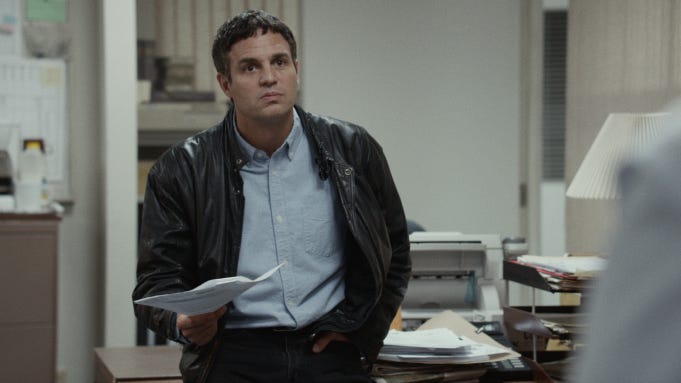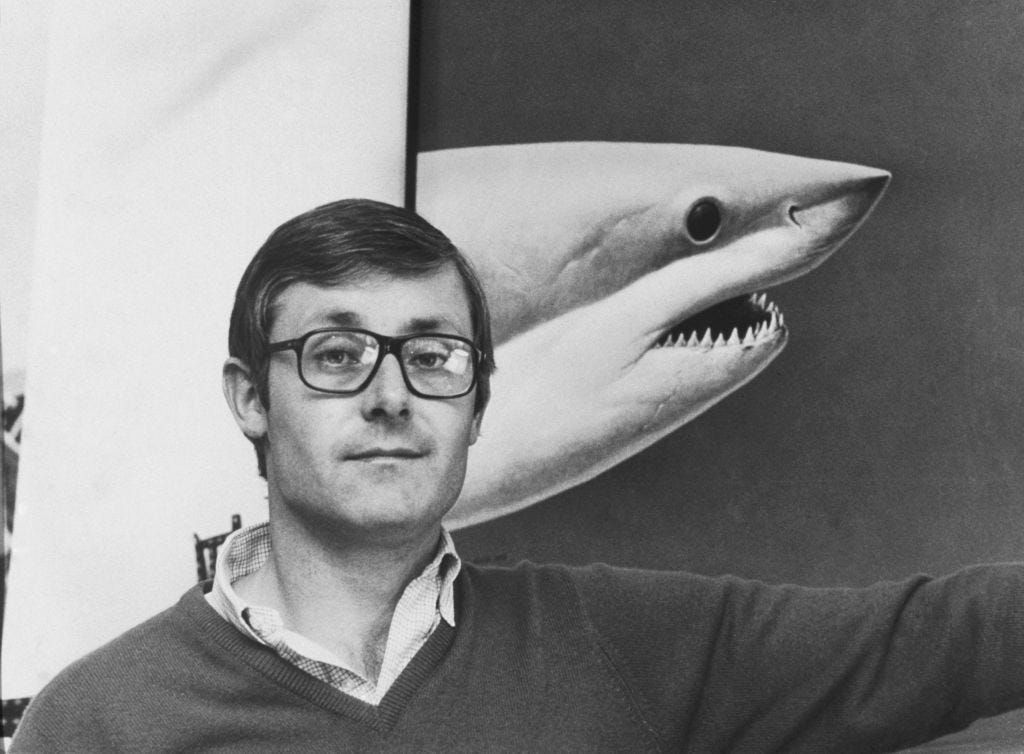IP Picks🔎: Is This the Next 'Spotlight'?
➕ 'Jaws' at 50 and S.A. Cosby agrees with this week's picks

Want to feel old? This summer marks the 50th anniversary of Jaws, the Great White thriller that ushered in the modern blockbuster era as we know it. On this exact day, June 20, a half-century ago, the movie opened on 409 screens in the US.
Since then, the movie has been celebrated in just about every way possible (other than the boatload of Oscars it deserves). But beyond that, the nightmarish production of Steven Spielberg’s epic has spawned a pop-culture cottage industry of documentaries, books and even a stage play. The troubles of getting Bruce (as the mechanical shark was known) to work, the tension between stars Richard Dreyfuss, Robert Shaw and Roy Scheider, and the ingenuity of its 27-year-old wunderkind director when it came to dealing with every challenge imaginable have passed into Hollywood legend.
Less attention, however, has been paid to the fascinating story behind the novel that led to all this. It starts with the book’s author, Peter Benchley, a struggling freelance writer who we'd probably write off today as a nepo baby. Looking to support his young family, Benchley signed on with a big-time agent in the early ‘70s, who did it as a favor to his famous-author father, Nathaniel (Benchley’s grandfather Robert was also a celebrated writer and a founding member of the Algonquin Round Table). The story behind Jaws takes place in a very different era in book publishing — a time when editors took authors for fancy, expense-account lunches (usually lubricated with booze) just to bat around ideas.
Benchley got no takers for his non-fiction ideas, but at one lunch, Tom Congdon, an editor at Doubleday, offhandedly asked Benchley if he’d ever considered writing a novel. Excitedly, Benchley mentioned an idea about a shark that terrorizes a Long Island beach town. He'd been toying with it ever since he read about the legendary Montauk shark hunter Frank Mundus. Intrigued, Congdon told Benchley that if he wrote up a quick pitch, he could get him $1,000 for the first hundred pages. (There was a big debate within Doubleday over whether or not $500 of that should be refundable if it passed on the project.)
In the end, Benchley was paid $7,500 to write the entire novel. Then he just procrastinated until his agent informed him that he’d have to return the advance if he didn't turn in something soon. Congdon loved the first five pages of Benchley’s shark tale, which would make it into the finished book more or less unchanged. But he didn't think much of the rest — it was too comic, apparently — and he instructed the young author to rework the book in the tone of the opening, which is how we got the terrifying masterpiece we all know.
Congdon and Benchley still had two sticky problems: A title and a cover. According to Benchley, they went through at least a hundred different titles (Congdon says 237): The Stillness in the Water. The Year They Closed the Beaches. A Silence in the Deep. The Summer of the Shark. The Jaws of Death. The Jaws of the Leviathan. On and on it went. Nothing seemed right.
“They all sounded dramatic, melodramatic or weird or pretentious," Benchley recalled. With 20 minutes left before the absolute drop-dead production deadline, Benchley told Congdon: "We cannot agree on a word that we like, let alone a title that we like. In fact, the only word that even means anything, that even says anything, is ‘jaws.’ Call the book Jaws." Congdon shrugged okay.
Benchley's original idea for the cover was an image of the terrorized beach town from the perspective of the shark's mouth (the UK cover gives an idea of what this would have looked like). But none of the mock-ups worked. They needed something grabby, especially since the title was so vague and ambiguous that it could’ve been mistaken for a medical textbook. Doubleday’s legendary design director, Alex Gottfried, turned to artist Paul Bacon, suggesting that he should try for a realistic shark, which is how Bacon came up with the now-iconic image of the shark swimming up from the bottom of the cover. Gottfried put the cherry on top by suggesting that a swimmer be added to give a sense of scale and danger.
As you can see above, the hardcover wasn’t quite there yet. The now-famous image would arrive with the paperback edition. Bantam's publisher, Oscar Dystel, thought the black-and-white hardcover version was too plain. So he tasked Roger Kastel (who later designed the movie poster for The Empire Strikes Back) with reading the book and coming up with a different take. Kastel thought the opening pages, which had inspired Bacon, were still the best. He simply added a flourish of color and a bit more realism. As for the movie poster, Universal ended up giving the image one final twist that made the whole thing pop: Blood-red letters for the title.

As a first-time novelist, Benchley and his book weren’t on anyone's radar at first. But Congdon was cautiously optimistic about what he had and sent Jaws to book clubs, which were a big deal financially and in terms of publicity, and paperback publishers (back then, publishers often sold off those rights separately). He was blown away by the response. Three different book clubs — Book of the Month, Playboy (yes, Playboy had a book club) and Reader's Digest — paid for their own editions. Meanwhile, after a six-way auction, Bantam offered $575,000 for the softcover rights, an astounding sum for the time and equivalent to about $4 million today.
It was at this point that Hollywood producers David Brown and Richard Zanuck got involved. Congdon sent galleys to media influencers, including Vogue, whose editor-in-chief, Helen Gurley Brown, was married to Brown. Someone on her staff at the magazine passed the Jaws galley on to Brown with a note: "Might make a good movie."
The Jaws hardcover would spend 44 weeks on the NYT bestseller list. And by the time the movie came out, the combined hardback and paper sales surpassed 5.5 million copies (lifetime sales are now estimated at north of 20 million).
Jaws would change Benchley's life. He initially figured that his take from the paperback advance, the book clubs and the movie rights (about $600,000 in 1970s dollars) would keep him writing for the next decade without worry. Benchley followed up Jaws with two more nautical-themed thrillers, The Deep and The Island, both of which were adapted for the screen, earning him huge paydays. In fact, the $2.15 million that Brown and Zanuck paid for The Island was the richest deal for a book’s rights at the time. By the mid-’90s, Benchley, perhaps regretting his own role in the demonization of sharks, became an advocate for their conservation. He would pass away in 2006 from pulmonary fibrosis at age 65.
One thing I love about this story is how it reminds us of the role of happenstance when it comes to creativity: An offhand question over a lunch of creamed mussels, a half-formed idea born of curiosity and sparked by a news item, a little development money, and a good editor/writer relationship. All of these things came together to produce a massive, unexpected hit. It's the development equivalent of just letting kids just run around the playground. We've lost some of that in an age of hover-parent development, regurgitated IP and now an AI where we get only the answer we think we're searching for.
The other thing I love is that it’s a testament to the leap of faith required to adapt a book for the screen. Jaws wasn't a very filmable book (despite the note pinned to the Vogue galley). In fact, Brown later admitted that if he and Zanuck had actually read the novel a second time, they probably wouldn't have bought it. As for Spielberg, his genius was his ability to see the movie that Jaws could become and not just the story it was. He streamlined the story by dropping its secondary plots, relocated Amity Island to a version of Martha's Vineyard, emphasized the action-packed final third, and tweaked the ending to add more drama. I think about stories like this all the time when I'm curating the Optionist. They’re a constant reminder that the most important thing is to imagine the movie that could be and not the movie that's printed on the page.
🔒 This Week: Genre Races
On to this week’s picks! One of my favorite new-ish mystery writers, S.A. Cosby, has a new book out (it was optioned very early on by the Obamas’ Higher Ground shingle). As part of the promotional tour, Cosby picked his recent favorites, singling out ones that deal with race or are set in his native South. A couple of them were previous Optionist picks (1,2) — obviously the man has great taste — that are amazingly still available. But some of the others caught my attention and their rights are still available as well. They kick off a week where most of our selections use genre to grapple with race.
✒️ A true-crime procedural about a journalist who frees a wrongly convicted man, which is positioned to be the next Spotlight (only with more action)
🗽 A mystery/drama about the murder of a Black activist at a Confederate monument protest in a small Southern town
🕵🏻♀️ A mystery about a trio of former teen detectives who reunite 25 years later to solve a new set of murders connected to their past
❄️ An Antarctica-set psychological horror tale that’s perfect for a Get Out-meets-Yellowjackets movie





